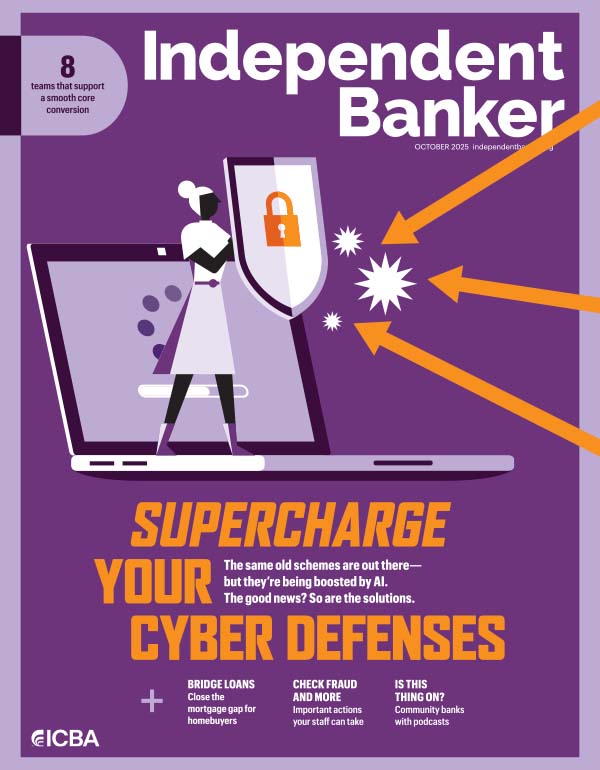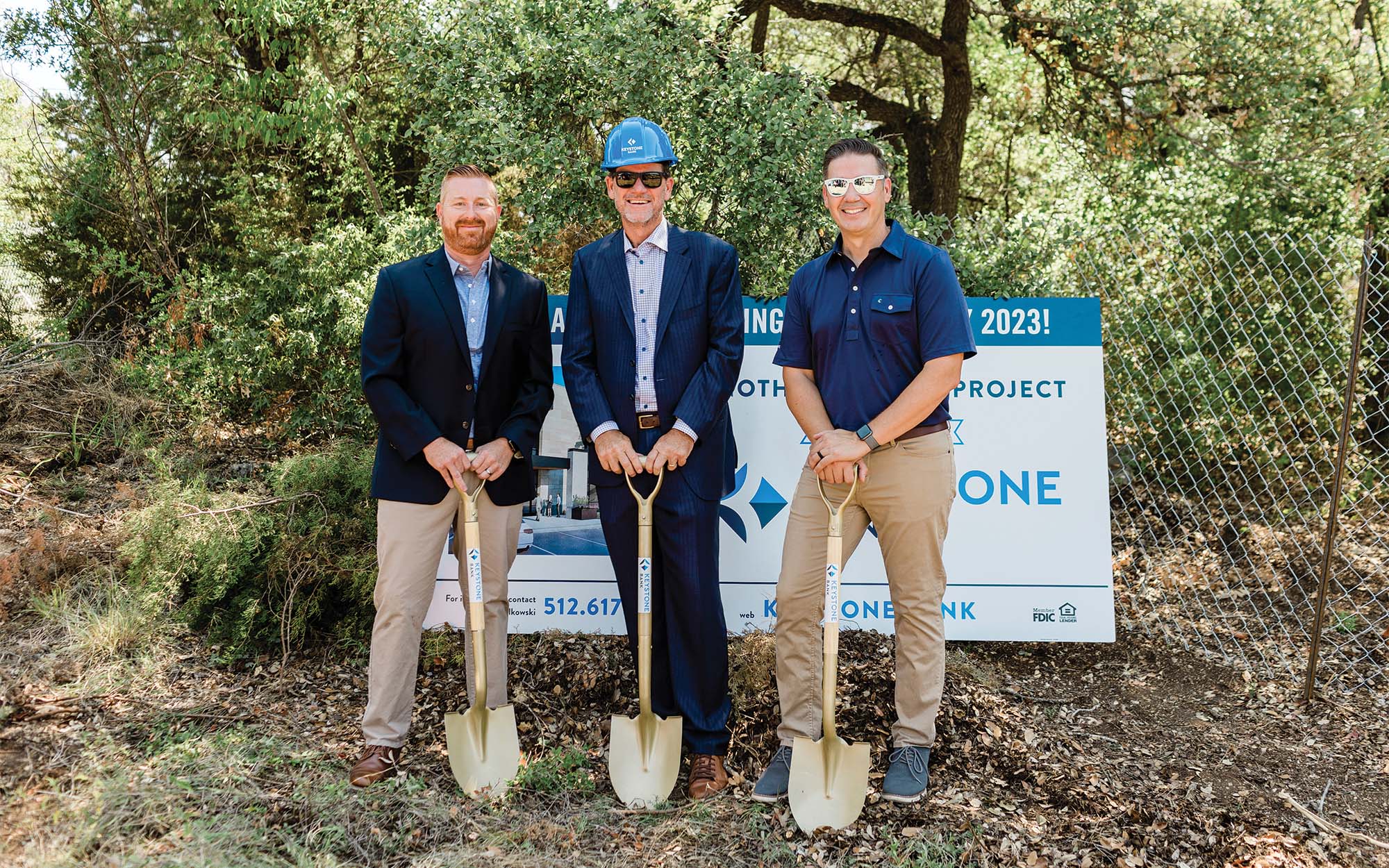When considering what makes for a stellar digital customer experience, the word “digital” increasingly seems superfluous. Nowadays, the digital customer experience is the main story, while what occurs in branches has been relegated to a subplot—albeit an important one.
For community bankers, though, this shift can be tricky to navigate.
“Community banks, much more than the big banks, owe their popularity to customers feeling that they know the people working there,” says Mitch Wein, head of community banking at Aite-Novarica Group in Boston. “If you deploy too much digital stuff in a way that depersonalizes the relationship, you risk throwing the baby out with the bathwater.”
That’s why balancing digital ease of use with online or mobile interactions that feel personal is high on most community bankers’ wish lists.
In the wake of the pandemic, says Whitney Stewart Russell, president of digital solutions for Fiserv, digital channels have become the primary way most financial institutions interact with customers.
“The digital experience,” she says, “has to be great, because customers are going to the digital channel first, even if they might follow up in a subsequent channel, whether it’s the branch or the call center.”
Here are some best practices for making sure that customers feel as loved online as they do in person.
1. “Look and feel” matters
When Ledyard National Bank in Hanover, N.H., began surveying its customers last year, the “look and feel” of the institution’s digital offerings were where most customers requested improvements, recalls Mike Parisi, senior vice president and chief strategy officer for the $750 million-asset community bank.
Parisi says that Ledyard quickly upgraded its digital interface, making it “clean, crisp and easy to use.”
In addition to a sleeker appearance, the community bank took steps so that screens loaded more quickly and that the online and mobile home pages were fully customizable.
“We accomplished what we set out to do,” says Parisi. “We brought the user experience into the 21st century.”
2. Make omnichannel a priority
Updating Ledyard’s digital image meant harmonizing the various interfaces so that there was a single look and feel for online and mobile users, says Parisi.
“Going from a desktop to a mobile device shouldn’t be a scary proposition,” he says. “An omnichannel approach is important.”
One way to foster consistency is by creating what Wein calls “change management guardrails,” or a written set of standards for color schemes, the flow of information and other key elements of digital design. “As changes occur, they have to line up with certain standards,” he says.
An omnichannel makeover extends beyond the cosmetic. It’s also important, Wein says, to make sure information, such as account balances, is rapidly updated across all channels. Customers expect whatever information they supply online to be available when contacting call center and branch employees.
“Whichever channel you interact with,” says Wein, “you want to be able to switch to a different channel in real time and know that the transaction integrity is retained.”
3. Figure out who owns what
Too often, an inconsistent digital experience stems from “a lack of communication between different areas within a bank,” Wein says.
Although this common breakdown has historically plagued larger banks, community banks are not immune. “A lot of community banks are growing and/or merging with other community banks, and that’s when it becomes more problematic,” he explains.
The solution, says Wein, is simple: Assign ownership of the digital experience to a C-level executive. Having a single leader at the helm makes it easier to view the digital experience holistically.
4. Rethink your website
With so many glittery new arrivals out there, from online account opening software to ChatGPT, it would be easy to neglect the humble website. But this would be a mistake, especially given the heavy traffic bank web pages see.
Last fall, Honor Bank in Honor, Mich., overhauled its site, rebuilding “from the ground up,” says Norman Plumstead, president and CEO of the $380 million-asset community bank. It scrapped an estimated third of website content to make the search experience more streamlined.
“You sometimes had to click three or four or five separate times to get an answer about business banking or mortgages,” recalls Plumstead. “It wasn’t good for SEO [search engine optimization], and more importantly, it made the website harder to use for customers.” Making the site more intuitive was an exercise in “addition by subtraction,” he jokes.
Creating a user-friendly website is “a huge opportunity,” agrees Fiserv’s Stewart Russell. She recommends envisioning your website “less as brochureware and more as a shopping experience.” Here, her guiding star is Amazon, which often presents shoppers with a number of similar choices, allowing them to base decisions on features as well as price.
“Think about needs and comparatives on your website, and make everything actionable,” Stewart Russell says. “Doing so can be a relatively light lift with a big return.”
5. Retain the human element in intelligent self-service
One advantage community banks have over megabanks is their relationships. “When I go on calls with our commercial lenders or branch managers,” says Plumstead, “I’m hearing straight from customers what they want to see or might not like about what’s happening digitally.”
Honor recently partnered with Banno through Jack Henry, its core provider, to upgrade the community bank’s user interface without allowing technology to compromise the customer experience. Plumstead, who admits to “not loving talking with chatbots,” is adamant that “the human element be part of everything we do.”
First Liberty Bank in Liberty, Texas, has a similar ethos. In 2018, when the $460 million-asset community bank installed 21 interactive teller machines (ITMs), customers were given a choice between self-service and speaking with live video tellers, says SVP and chief operations officer Jonathan Galeano.
At first, recalls Galeano, some customers balked, comparing the ITMs to “the self-service line at Walmart.” Now, he says, customers are known to bypass the branch staff and head straight for an ITM to interact with the bank’s five video tellers, each of whom has attracted a customer following.
6. Add value whenever possible
Community banks that provide online credit scores are enhancing the user experience, says Fiserv’s Stewart Russell. She would like to see more community banks supplement these scores by suggesting ways to put credit information to practical use.
“Sometimes I think we rush to put in content that’s not contextual,” says Stewart Russell. A better option, she says, is providing “an experience around scores that is advisory.”
If, for instance, a customer’s credit score is low, banks might suggest ways to make improvements. On the other hand, when a person in their 20s or 30s receives a high score, that information could be enhanced by educational materials on buying a first home or applying for a mortgage.
7. Survey your customers
Ledyard National Bank serves a range of demographics. Some of its customers are Gen Zers and use the branch next to the Dartmouth campus, while others choose Ledyard for its wealth management arm, explains Parisi.
“[Customer surveys] completely reframed how we look at the client experience. We never imagined the level of information we’d get from our clients, and in many ways, this has changed who we are as a bank.”—Mike Parisi, Ledyard National Bank
“We’re trying to cater our services to the younger generation, but also to an older, more well-established client base that has accounts with Fidelity and Schwab,” he says. “For these customers, our digital services have to rival those of the largest banks and financial services companies out there.”
When it came to improving its digital experience, Ledyard went straight to the source. Last year, the bank began surveying its customers through third-party provider Avannis.
Responding to customer feedback, Ledyard now offers both Zelle, an app for sending and receiving money, and MoneyMap, an account aggregator and budgeting tool, says Parisi. The bank also responded to customer input by raising its limits on mobile remote deposit capture.
The surveys, Parisi says, have “completely reframed how we look at the client experience. We never imagined the level of information we’d get from our clients, and in many ways, this has changed who we are as a bank.”
8. Harness data for a more customized experience
As the number of visits to Honor Bank’s branches continues to decline, Plumstead is keen “to figure out different ways to connect with [our customers] and understand them.”
“Because of technology, our ability to use data to create new experiences is so much better than it ever has been.”—Whitney Stewart Russell, Fiserv
Chief among plans for digital enhancements is a data analytics platform that could take the community bank’s tremendous stockpile of customer data and turn it into tailored offers or educational materials.
Fiserv’s Stewart Russell would also like to use AI and other cutting-edge technologies to help community banks be more useful to customers in their digital channel offerings. “Because of technology, our ability to use data to create new experiences is so much better than it ever has been,” concludes Stewart Russell. “We want to target what users need and what they’re trying to accomplish in their lives … We’re going to get to the place where we can offer one-on-one advice and experiences.”
Will ChatGPT change the user experience?
Nov. 30, 2022, the day ChatGPT was released, will be remembered as “the day that AI reached the mass consciousness of humanity,” says James Robert Lay, author of Banking on Digital Growth.
Everyone has heard the buzzwords, but what exactly are generative AI and ChatGPT?
Generative AI, according to consultant McKinsey, “describes algorithms [such as ChatGPT] that can be used to create new content, including audio, code, images, text, simulations and videos.”
While ChatGPT is stealing headlines, implications for community banks remain unclear. Mitch Wein, head of community banking at Aite-Novarica Group in Boston, for instance, is convinced that AI will transform the digital customer experience after banking-specific models are built.
This may mean that most community banks will be exposed to AI through core vendors, which will incorporate AI into their offerings. Others will wait for fintechs to figure out how ChatGPT-powered functions can elevate the customer experience in loan originations and call centers.
The true value of AI, says Wein, will be experienced after algorithms have been trained “to understand banking terms and constructs … I think augmented technology is going to be more powerful for community banks than the technology purely by itself.”
Give gamification a spin
In 2021, $425 million-asset Chelsea Savings Bank in Chelsea, Mich., began offering an online savings and financial education platform through Plinqit as the higher-tech equivalent to its discontinued Christmas club accounts, according to president and CEO Joanne Rau.
Plinqit, she explains, allows customers of the community bank to save for an array of goals above and beyond holiday gift-giving.
Currently, more than 100 customers use Plinquet, with the lion’s share doing so on their phones. The Plinqit app helps them accumulate wealth by rewarding them for saving in a “fun and engaging manner,” says Rau. Plinqit also encourages financial wellness by depositing small sums into users’ accounts after they’ve read articles on finance and passed short quizzes.
Employing the same techniques and enticements as video games to instruct or reinforce positive behaviors is known as “gamification.” Kathleen Craig, CEO and founder of Plinqit, describes gamification as “a secret weapon” for community banks seeking “to enhance the digital experience and create lasting connections with their customers.”
“Gamification leads to higher customer engagement, and research shows that fully engaged customers are more loyal and profitable than the average customer,” says Craig.
Cara Macksoud, CEO of Money Habitudes, a gamelike assessment of an individual’s financial attitudes, agrees. “Right now, there’s an enormous wealth transfer from baby boomers to the next generation, and the next generation grew up on gamification,” she says. “Gamification can make a bank seem friendlier to its customers.”
Is your user experience accessible?
“Accessibility is addressing user-experience ‘bugs’ that affect people with disabilities,” says Mark Miller, director of sales for TPG Interactive, a digital accessibility consultancy based in Clearwater, Fla.
Making the user experience as bug-free as possible is not only a requirement of Title III of the Americans with Disabilities Act (ADA); it’s also an excellent way to address all customers’ needs.
One of the most helpful fixes is ensuring your website is navigable with a keyboard. Doing so helps people who are blind and reading on screen readers and those with mobility impairments who often cannot operate a mouse, says Miller.
Testing keyboard navigability is simple. “Stick your mouse in a drawer and see if you can get through your website with just a keyboard,” suggests Miller. He notes that making a website easier to navigate by keyboard is also a boon to “power users,” or those who find navigating by mouse too slow.
Miller is convinced that improving accessibility brings unanticipated benefits. He says that when city planners began cutting out small ramps in sidewalks to satisfy the ADA and help wheelchair users exit curbs safely, researchers found that 80% of nondisabled pedestrians chose the cutout—even without a perceivable reason to do so. These cutouts are also convenient for people pushing strollers or luggage.
“This one change—creating a curb cutout—turned out to have a huge benefit to the population in general,” says Miller. “When you make something accessible to people with disabilities, often there’s a ripple effect that makes the user experience better.”






